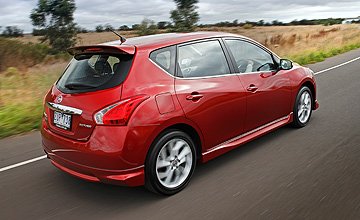BY MIKE COSTELLO | 12th Jun 2013

More Australians buy this bodystyle to begin with, but then Nissan has gone and priced it from $18,990 - $500 less than any major rival and $1000 less than the equivalent sedan. , , But its not so much this base price we are really interested in. Rather, its those hot turbocharged versions further up the range – the $24,990 ST-S and the $29,240 SSS. , , Australians buy a disproportionate number of hot hatches compared to other markets – some brands report a quarter of their sales of a given model are the sporty version – and Nissan’s return to the SSS moniker is sure to resonate with boy racers who’ve missed it in its long absence. , , Under the bonnet of both the ST-S and SSS sits a turbocharged 140kW/240Nm 1.6-litre engine matched to a six-speed manual gearbox or a CVT with token paddle shifters. , , It’s a punchy little number, with no perceptible lag and a willingness to rev out past 6000rpm at the drop of a hat.
It also has a meaty torque curve, with all 240Nm available down at 2000rpm. , , Nissan hasn’t given us the numbers, but a colleague and yours truly clocked a 7.9 second 0-100km/h sprint time on a damp road, which is nothing to be sneezed at. , , We are also fans of the short-stack manual shifter, which pairs up well with the meaty little engine, and the ride quality on 17-inch alloy wheels, which is compliant without being bouncy. Nissan tweaked the damper rates on the SSS, but hasn’t said exactly how. , , However, the rest of the dynamic package isn’t quite as needle sharp. , , We drove both the ST-S and SSS in manual guise, and each exhibited the same vague electric steering feel as the entry versions, the same propensity for tyre scrubbing understeer right at the limit, and the same hints of bodyroll and axle tramp., , The cheaper but similarly swift 132kW Holden Cruze SRi and SRi-V turbo versions, which have had more substantial local calibration that the Pulsar, are ultimately sharper drives.
Still, the warmed-up Pulsars are sharp value and plenty swift for the money. , , Cabin fit and finish is decent too. The cheap faux metal highlights aren’t great, and the overall design is a touch dowdy, but it feels like it’s built to last. , , The SSS gets a boy racer bodykit, leather seats, dual-zone climate control, six-speaker audio system that includes Bluetooth streaming, an excellent touchscreen satellite navigation system, reversing camera, and keyless entry and start – not bad for the money. , , The ST-S, though, is the real bang-for-bucks option. It lacks the aforementioned equipment – the deletion of Bluetooth audio streaming is poor – but is just as quick., , Our drive day in the hatch also saw us get behind the wheel of the regular ST-L, which is powered by the same 96kW/174Nm 1.8-litre engine as used in the sedan.
Ours had the optional $2250 CVT automatic transmission, taking the price out to $24,740. , , The engine has less power than, say those in the Cruze, Mazda3 and Hyundai 30, but is willing enough. It is, however, hobbled with a CVT that occasionally fusses and fidgets to get the right ratio, especially on an incline. , , As with the sedan, the cabin is more spacious than average, with truly excellent rear seat room. Unlike the sedan, the rear seats also fold down to liberate more cargo space., , But at this price point we’d like to see a touchscreen interface, Bluetooth audio streaming and reversing camera, which feature – or are at least available – on some similarly priced rivals. , , So, how to sum up this Pulsar range?, , The base versions have heaps of space and are well-priced, but also compete against some high-quality rivals. Nissan will need that strong nameplate to wrest sales from Toyota, Mazda, Holden and Hyundai. , , The SSS and ST-S, meanwhile, give the range some welcome edge, with an excellent turbo engine. They’re not precision tools, but will still put a smile on your dial.